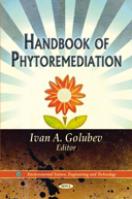Descrição
CONTENTS:
Chapter 1 – Phytoremediation of Phenolic Compounds: Recent Advances and Perspectives
Chapter 2 – Phytoremediation: An Option for Removal of Organic Xenobiotics from Water
hapter 3 – Phytoremediation of Uranium Contaminated Soils
Chapter 4 – A Decade of Research on Phytoremediation in North-East Italy: Lessons Learned and Future Directions
Chapter 5 – Phytoremediation of Heavy Metal Contaminated Soils: Plant Stress Assessment
Chapter 6 – Reviews on Soil Pollution, Risks, Sources and Phytoremediation Involving Metals Contaminants
Chapter 7 – Phytoremediation: A Promising Technology of Bioremediation for the Removal of Heavy Metal and Organic Pollutants from the Soil
Chapter 8 – Looking for Native Hyperaccumulator Species Useful in Phytoremediation
Chapter 9 – Use of X-ray fluorescence-based analytical techniques in phytoremediation
Chapter 10 – Sustaining Remediation of Secondary Saline and/or Sodic Soils in Conjunction with Field Management
Chapter 11 – Phytoremediation of Heavy Metals using Poplars (Populus spp): A Glimpse of the Plant Responses to Copper, Cadmium and Zinc Stress
Chapter 12 – Phytoremediation using Constructed Mangrove Wetlands: Mechanisms and Application Potential
Chapter 13 – Use of Legume-Microbe Symbioses for Phytoremediation of Heavy Metal Polluted Soils: Advantages and Potential Problems
Chapter 14 – Phytoremediation Technologies for the Removal of Textile Dyes: An Overview and Future Prospects
Chapter 15 – Analytical Strategies towards the Study of Metallophytes Plants Growing in Cu-Ni Mining Areas in Botswana
Chapter 16 – Phytoremediation of Cd, Pb and Cr by Woody Plants
Chapter 17 – Impact of Plant Growth Promoting Rhizobacteria Pseudomonas in Phytoremediation Process
Chapter 18 – Arsenic in the Environment: Phytoremediation Using Aquatic Macrophytes
Chapter 19 – Hairy Root Studies in Phytoremediation and Phytomining
apter 20 – Application of Phytoremediation from Experimental Stage to Practical Stage: Comparative Study in the Southern Part and the Northern Part of the European Region
Chapter 21 – Genetic Biodiversity of Maize and Sunflower Commercial Cultivars and their Phytoextraction Capability of a Multi-Metal Artificially Polluted Soil
Chapter 22 – Ecological Aspects of Selenium Phytoremediation
Chapter 23 – Experimental Systems in Agrochemicals-Contaminated Soils Phytoremediation Research
Chapter 24 – Silver Nanoparticles Produced by Living Plants and by using Plant Extracts
Chapter 25 – Eco-Environmental Consequences Associated with Chelant-Assisted Phytoremediation of Metal-Contaminated Soil
Chapter 26 – Salt Marshes: An Interesting Ecosystem to Study Phytoremediation
Chapter 27 – Prior to a Successful Phytoextraction: Pot Experiments and Field Scale Studies on the Total Removal Capacity by Garden Flowers Grown in Cadmium-contaminated Soils in Taiwan
Chapter 28 – The Role of Arbuscular Mycorrhizal Fungi in Phytostabilization and Phytoextraction of Heavy Metal Contaminated Soils
Chapter 29 – Bacterial ACC Deaminase and IAA: Interactions and Consequences for Plant Growth in Polluted Environments
hapter 30 – Considerations on Chemically-Enhanced Phytoextraction of Pb using EDTA under Field Conditions
Chapter 31 – Field-scale rhyzoremediation of a contaminated soil with hexachlorocyclohexane (HCH) isomers: the potential of poplars for environmental restoration and economical sustainability



